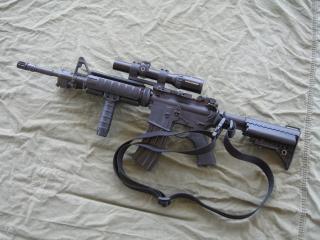
 The Wilderness Single-Point sling with the Daniel Defense mount.
I looked at four single-point slings. The first was from The Wilderness
Tactical. It connects to the receiver to stock junction using a flat loop, and
has an emergency release buckle which breaks the loop around the shooters body.
The second was the Specter Gear MOUT sling. This sling has a one inch loop
which connects to a flat mount at the receiver junction and provides more
flexibility from the main body loop. It has a release buckle which releases the
entire body loop from the one inch loop connected to the weapon.
The next two single-point slings I evaluated use a snap-hook instead of a web
loop to connect to the receiver. The Troy CQB One-Point Sling has an
approximately six-inch offset strap from the receiver to the body loop. Its
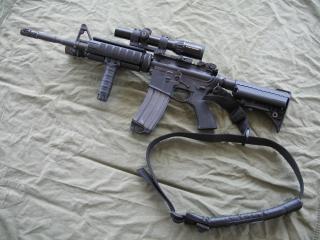
 Troy CQB One-Point Sling (CQBOPS) with a Yankee Hill Machine (YHM) single-point plate.
body loop is also padded. This sling provides additional freedom of movement
with the weapon, but retains it in position when slung the least. The Blackhawk
Industries ZM Single Point Sling also snaps into the receiver mount, but has no
offset loop. The distinguishing feature of the Blackhawk ZM sling is that its
body loop is partially bungee cord, which can offer additional freedom of
movement, but still retains the weapon reasonably well during transitions.
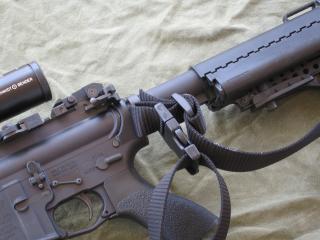
 The Wilderness' single-point sling is threaded through the Daniel Defense
"Burnsed Loop" mount.
The second type of sling is the two-point, which connects to the front and rear
of the weapon, similar to the old loop slings. Modern two-point slings generally
use sling mounts on the side of the weapon instead of the bottom, to facilitate
carry of rifles and carbines which have protruding box magazines. Two-point
slings provide more control over the weapon when slung than the single-point,
and they can be used in all the carry positions as the original loop slings. The
primary limitation of conventional two-point slings is that they are not
adjustable on the fly, leaving them either too short to shoot while slung, or
too long to use for carry.
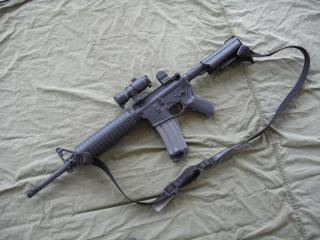
 Blue Force Gear's two-point Vickers Combat Applications Sling, on a simple
M4-style carbine.
Kyle Lamb of Viking Tactics developed the VTAC sling, a two-point which is
adjustable on the fly for length. It can be loosened while shooting, and
tightened up for carry. Another more recent adjustable two-point sling is the
Vickers Combat Applications Sling, sold by Blue Force Gear. It operates
similarly to the VTAC sling, but uses a different adjuster and has an emergency
release buckle. These modified two-point slings have many of the advantages of
both the three-point and single-point slings, but few of the "cons".
These modified two-point slings have another advantage in that they can be
attached to the rifle in different places. The rear attachment point can be at
the rear of the stock or at the stock to receiver junction; the front attachment
point can be near the front sight base or nearer to the receiver. This
flexibility allows the shooter to set it up for maximum freedom of movement as
well as control of the weapon. When he slings or deploys the weapon, he can
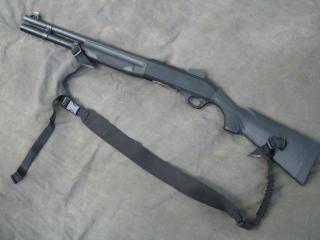
 The SPEC-OPS BRAND Master Blaster two-point sling is adjustable and has a
quick-release buckle, along with its wide strap for comfortable carrying.
quickly adjust the sling length to optimum for the task at hand. The SPEC-OPS
Brand Master Blaster two-point sling has a wide loop for load-bearing ease, but
uses a length adjust buckle more difficult to adjust on the fly than the VTAC or
Vickers slings.
The third type of sling is the three-point sling, which connects to the front
and rear of the weapon, and has a slider so the loop around the shooter's body
connects to the main loop about halfway back from the sling's forward attachment
point. Three-point slings provide more control of the weapon than the other two
types, and they allow more carry modes. The primary advantage of the three-point

 The Wilderness Giles Tactical Sling is an excellent choice for a basic
three-point sling. It is shown using Knights Armament quick-detach (QD) sling
swivels.
sling is that it does a good job retaining and controlling the rifle when
transitioning to pistol. When the rifle is dropped using the three-point sling,
it will generally hang diagonally across the front of the body, with good muzzle
control. When slung in this position, it is easy to walk, and the gun can be
rotated around to the shooter's side or back to get it out of the way.
The three-point sling can also carry the rifle like a back-pack, which
is useful when climbing or other activities which require no frontal
obstructions.
|